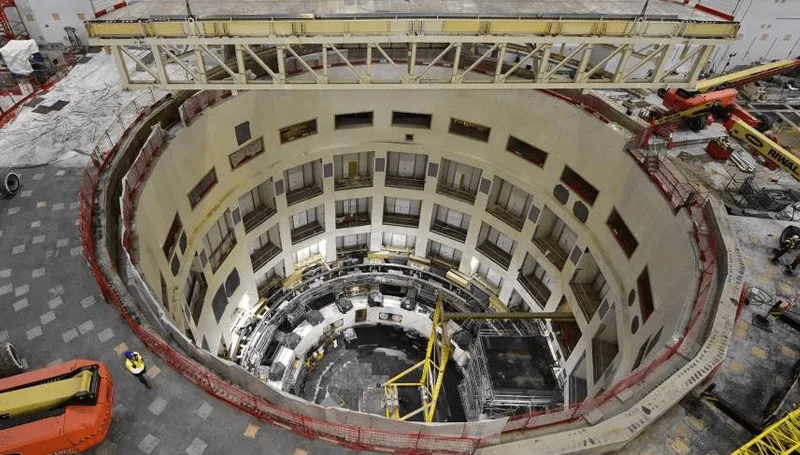Nuclear Fusion Energy: Can We Build a “Sun in a Bottle” to Solve the Energy Crisis?

Between dwindling fossil fuel reserves, and inefficient clean energy efforts, nuclear fusion stands out as a candidate for solving the energy crisis. It promises to provide almost limitless energy with a low environmental cost.
Fusion reactors harness the same process that powers our sun, and scientists aim to create what is essentially a “sun in a bottle” here on Earth to power up civilization. The process is complex, but if its successful, this technology may shape the future energy landscape for years to come.
What is Nuclear Fusion?
Nuclear fusion happens when two light atomic nuclei combine, forming a single heavier nucleus. This process releases a tremendous amount of energy, and produces almost no waste.
Nuclear fusion is not to be confused with nuclear fission. In nuclear fission, the opposite happens. A single heavy atom is split into smaller atoms. This also creates a lot of energy, but it produces long-lived radioactive waster and carries risks. Fusion is much cleaner and safer.
The most promising materials to replicate nuclear fusion on Earth are isotopes of hydrogen (deuterium and tritium). Deuterium is abundantly found in ordinary water, making it an inexhaustible source of energy. Tritium is rarer in nature, but it can be made within the fusion reactor using lithium.
To initiate fusion, these isotopes are excessively heated to temperatures reaching tens of millions of degrees Celsius. This forms a plasma, or a superheated ionized gas. At these extreme temperatures, the nuclei move so fast to the point their natural electrostatic repulsion becomes redundant, and they start to fuse. Releasing massive amounts of energy.
The challenge is to contain and sustain this incredibly hot plasma… this is why it’s often called a “sun in a bottle”.
The Promise of Fusion Energy
Fusion energy has tremendous potential to solving the energy crisis of today
Safe, Clean Energy
fusion is an exceptionally clean energy source. Helium is inert and non-radioactive, and it’s also abundant. Unlike fossil fuels, the process of fusion does not generate carbon emissions or other harmful pollutants.
While tritium may be radioactive, it has a short half-life of 12.3 years, compared to the “forever” radioactive waste produced by current fission reactors. A fusion reactor doesn’t even need a lot of tritium to run, reducing the waste even more.
Fusion is inherently safer, since there’s no risk of a runaway chain reaction. If there’s any issue, the plasma can be simply cooled down and the reaction will stop. There’s no risk of a nuclear meltdown.
Deuterium, the fuel source, is abundant, and can be readily extracted from seawater. It provides an energy supply that can last for millions of years. While tritium is less common, it can be made from lithium which is also abundant. This makes the fuel sources readily available for generations.
The Challenge of Building a “Sun in a Bottle”
Despite its immense potential to change the future of energy, fusion energy has acquired this mythical “holy grail” status in the scientific world, because of how complex it is to apply it in reality. The press often advertised it as “20 years away”, which has remained perpetually out of reach.
Plasma Confinement
The primary practical hurdle to the fusion energy dream. How do you maintain a plasma temperature that is hotter than the sun, while preventing it from touching the reactor wall? Two methods have been proposed for this:

Magnetic Confinement: Using powerful magnetic fields to contain superheated plasma. Tokamaks (torus-shaped champers) and Stellarators are the leading candidates for the design.
Inertial Confinement: Using high-powered lasers or particle beams to compress and heat small fuel pellets, initiating fusion before it expands. This has proven useful for scientific study, but not yet on a large scale.
Other Technological Challenges
Even with plasma confinement, the reactor wall needs to be made from a material that can withstand high heat, corrosion, and constant bombardment by high-energy neutrons. Developing robust materials for construction is crucial if fusion energy is ever to become viable.
There’s still some engineering challenges with converting the generated heat into usable electricity, and managing the tritium fuel cycle in an efficient manner.
The initial cost of building the reactor is also staggering, and the timelines for development are long. It needs to be proven that this technology is economically viable before it can be used on a wide scale.
ITER and the Road Ahead
The International Thermonuclear Experimental Reactor (ITER) is the entity spearheading the most advanced research in magnetic confinement today. It is a colossal project in France that involves 35 different countries. The project is not meant to generate electricity for the grid, but rather to demonstrate the viability of this new technology for widespread adoption.
The project has ambitious goals. It needs to produce a fusion plasma with a thermal power output ten times greater than the input heating power (a Q value of 10), and it needs to sustain this output for an extended duration. It’s also a chance to demonstrate the minimum technologies and operations required for a successful fusion power plant.
The ITER is a huge project, featuring the world’s most powerful superconducting magnets, but it still faced delays. The current projected timeline is 2033-2034 for the initial plasma ignition, and deuterium-tritium operations by 2039. These operations are meant to test all the theoretical concepts in a working, integrated system.
Other Players
Beyond ITER, other public and private ventures are exploring this future energy. Companies like Helion and Commonwealth Fusion Systems (CFS) have significant investments, and are pursuing innovative approaches to hopefully make nuclear fusion viable sooner.
The National Ignition Facility (NIF) in California is also a major player. They specialize in inertial confinement fusion. In December 2022, their experiments demonstrated scientific breakeven for the first time (I.e. when the output energy is more than the input), with an energy gain factor of 1.5.




